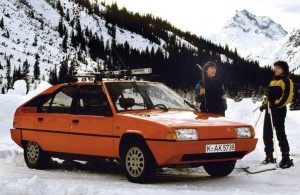
In der Ausgabe 70 vom 4. Oktober 2012 berichtet die “Citroën Equipe”, das Händlerinformationsportal der Citroën Deutschland GmbH, vom Jubilar:
Im Oktober 1982 – also genau vor 30 Jahren – wurde der Citroën BX auf dem Pariser Salon vorgestellt. Die Mittelklasselimousine mit hydropneumatischer Federung setzte neue Akzente in Aerodynamik, Karosseriebau und Wirtschaftlichkeit. Im Innenraum wurden die Bedienungssatelliten in das Armaturenbrett mit seinem Lupentacho integriert.
Die Karosserie mit streng geometrischen Linien ist Schöpfung des italienischen Designers Marcello Gandini aus dem Hause Bertone. Rundungen waren tabu. Eine besondere Innovation war der Leichtbau der Karosserie: bei den Stoßstangen, der Motorhaube, der Heckklappe und der C-Säulenverkleidung wurden Kunststoffe eingesetzt. Zudem war die Karosserie die erste bei Citroën, die am Computer geplant und entwickelt wurde.
Die Hinterachse war mit gezogenen Längslenkern und längs liegenden Federelementen ausgestattet. Die geschickte und platzsparende Achsaufhängung ermöglichte einen ebenen Kofferraum. Neue Maßstäbe setzte der besonders sorgfältige Korrosionsschutz unter Verwendung von galvanisiertem Stahl und Zinkbeschichtung.
Ab 1985 stellte Citroën drei Kombiversionen vor: BX 16 RS Break, BX 19 TRS Break und BX 19 RD Break. Es folgte der BX 4 TC „Evolution“, die Gruppe B Version des Citroën BX mit einer verlängerten Front, da der 2,15 Liter Turbo-Motor längs eingebaut war.
Zunächst standen zwei Motorisierungen zur Verfügung: ein Motor mit 1360 cm3 und 62 (oder 72) PS und einer mit 1580 cm3 und 90 PS. Die beiden gehobenen Ausstattungsvarianten 14 E und 14 RE wurden mit Fünfganggetriebe und einer Leistung von 72 PS angeboten. Im April 1984 war der Citroën BX mit einer 1,9-Liter Dieselvariante mit 64 DIN-PS erhältlich. Ab November folgte der Citroën BX GT mit 1.891 cm3 und 105 PS, auf dem später das Sondermodell BX Digit mit vollständiger digitaler Instrumenteneinheit folgte.
1987 erschien ein Facelift: mit großen weißen Blinkern und breiten Kotflügeln, neuen Stoßstangen und einem neu gestalteten Armaturenbrett mit konventionellen Rundinstrumenten- und Bedienungselementen. Es folgten zwei weitere besondere Motoren: im Jahr 1987 der 1,9 Liter GTi 16V mit 158 PS (ab 1988 mit 147 PS) als erster in Großserie produzierter französischer 16V-Motor mit serienmäßigem ABS; 1988 dann der 1,8 Liter Turbodiesel mit 90 PS.
Von den Citroën BX-Modellen wurden in den Jahren 1983 bis 1993 insgesamt 141.228 Fahrzeuge in Deutschland verkauft. Weltweit waren es 2.315.739 produzierte BX-Fahrzeuge.
Im Original hier:
Somit können wir uns freuen, in den nächsten Monaten die ersten Citroën BX mit historischem Kennzeichen (“H-Kennzeichen”) begrüssen zu dürfen…!
Dank auch an Markus Willach für die Faktenrecherche zum BX-Artikel.
Citroën BX – an edgy design
In its issue #70 published 4 October 2012 the “Citroën Equipe”, the German dealer’s information portal published by Citroën Germany GmbH, recognizes a special anniversary:
“…In October 1982 – exactly 30 years ago – the Citroën BX was unveiled at the Paris Salon. The midsize sedan with hydropneumatic suspension set new accents in aerodynamics, chassis and economy. Inside the switch satellites were integrated into the dashboard speedometer with a magnifying glass.
A body with strong geometric lines was created by Italian designer Marcello Gandini working for Bertone. Round curves were taboo. A particular innovation was the lightweight body: at the bumpers, the hood, the rear hatch and the C-pillar trim plastics were used. Moreover, at Citroën the body was the first which was designed and developed on a computer.
The rear axle got equipped with trailing arms and drawn lengthwise spring elements. The clever and compact axle suspension allowed for a flat cargo area. New standards of particularly careful corrosion protection were reached using galvanized steel and zinc coating.
From 1985, Citroën launched three estate versions: BX BX 16 RS Break, BX 19 TRS Break and BX 19 RD Break. Later the BX 4 TC “Evolution” was launched, the Group B version of the Citroën BX with an extended front as the new 2.15 liter turbo engine was mounted longitudinally.
Initially two engines were available: an engine with 1360 cm3, and 62 (or 72) PS and one with 1580 cm3 and 90 PS. The two upper trim levels 14 E and 14 RE were offered with five-speed transmission and an output of 72 PS. In April 1984, the Citroën BX is available with a 1.9-liter diesel version with 64 DIN hp. From November, the Citroën BX GT was followed with 1891 cm3 and 105 hp, the later with the special model BX Digit with all digital instrument cluster.
From 1987, the BX received a facelift: with large white turn signals and wide fenders, new bumpers and a redesigned dashboard with conventional round dials and controls. Two more special engines: in 1987, the 1.9 liter GTi 16V with 158 hp (from 147 hp in 1988) was the first mass-produced in French 16V engine with ABS as standard. In 1988, the 1.8 liter turbo diesel with 90 PS followed.
Of the Citroën BX models in the years 1983 to 1993 a total of 141,228 vehicles sold in Germany. Worldwide, there were 2,315,739 vehicles produced BX…”
We’d like to thank Citroën Deutschland GmbH for remembering us – and you – about this great car which from this month onwards can be counted into the historic section of automobiles (that’s what in Germany is defined for cars older than 30 years)…
Also big thanks to Markus Willach to verify the facts for and with us.
—–
30 ans de la Citroën BX
Dans le numéro 70 du 4 Octobre 2012 la “Citroën Equipe”, la publication pour les concessionnaires Citroën en RFA et edité par Citroën Deutschland GmbH, parle sur l’anniversaire:
“…En Octobre 1982 – exactement 30 ans – la Citroën BX a été dévoilé au Salon de Paris. La berline de taille moyenne avec suspension hydropneumatique mettre de nouveaux accents dans l’aérodynamique, châssis et de l’économie. A l’intérieur des satellites ont été intégrés dans le tableau de bord avec tachymètre en loupe.
Un corps avec une forte création de lignes géométriques, dessiné par l’italien Marcello Gandini du maison Bertone. Arrondis étaient tabous. Une innovation particulière a été le corps léger: au pare-chocs, le capot, le hayon et les C-pilier de finition matières plastiques ont été utilisés. En outre, le corps a été le premier à Citroën, qui a été conçu et développé sur un ordinateur.
L’essieu arrière équipé de bras oscillants et tiré de la longueur des éléments élastiques. La suspension de l’essieu intelligent et compact a permis un espace de chargement plat. De nouvelles normes de protection contre la corrosion particulièrement attentif continué à utiliser l’acier galvanisé et revêtement de zinc.
A partir de 1985, trois versions de la break Citroën BX sont realisé: BX 16 RS Break, BX 19 TRS Break et la BX 19 RD Break. Après la BX 4 TC “Evolution” etait lancé, la version Groupe B de la Citroën BX avec un front étendu, parce qu’il y avait le moteur 2,15 litre turbo monté longitudinalement.
Au départ, deux moteurs sont disponibles: un moteur de 1360 cm3 et 62 (ou 72) PS et un moteur avec 1580 cm3 et 90 PS. Les deux niveaux de finition supérieure 14 et E 14 RE ont été proposés à cinq vitesses et une sortie de 72 PS. En Avril 1984, la Citroën BX est disponible avec une version diesel 1,9 litre avec 64 DIN pS. De Novembre, la Citroën BX GT a été suivie avec 1891 cm3 et 105 PS, le plus tard avec le modèle spécial “BX Digit” avec tous les tableau de bord numérique.
1987 semblait une cure de rajeunissement: avec de grandes clignotants blancs et les ailes larges, pare-chocs et nouveaux un tableau de bord redessiné avec cadrans ronds traditionnels et des contrôles. Deux moteurs plus spécifiques: en 1987, le 1,9 litre GTi 16V avec 158 PS (147 PS à partir de 1988) a été le premier produit en masse en 16v français avec ABS de série; et en 1988, de 1,8 litres turbo diesel de 90 PS.
Dans les années 1983 à 1993 un total de 141.228 véhicules des modèles Citroën BX sont vendus en Allemagne. Dans le monde, il y avait 2.315.739 véhicules produits BX…”
Regardez l’article en original ici:
Nous tenons à remercier Citroën Deutschland GmbH pour nous rappeler – et vous – à propos de cette superbe voiture qui à partir de ce mois est à compter dans la section historique de l’automobile (c’est ce que l’Allemagne est compté pour les voitures de plus de 30 ans)…!

